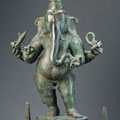|
|
 |
 |
| Ganesha |
|
|
Shiva and Parvati have two children: Ganesha and Skanda, who is known by many other names, such as Karttikeya, Subrahmanya, and Murugan. The family is often portrayed together, but each member is also worshiped independently. Neither Ganesha nor Skanda was born in a conventional way. Skanda was actually born of the six Krittakas, stars known as the Pleiades. Ganesha's strange appearance, with an elephant's head and human body, is explained by the unusual manner of his birth (Figures 1 and 2): his mother brought him into being independently, out of a model made of dirt, and Ganesha was born while his father was away from home. A loyal son, Ganesha stood guard outside his mother's bathroom as she washed. When Shiva returned, he could not tolerate an unknown man standing outside his wife's bathroom, and in the ensuing conflict, Shiva vanquished his son by decapitating him. Distraught, Parvati explained Ganesha's origin to Shiva, the child's "father," and Shiva sought to make amends by ordering that the first available head be brought to him to revive his son; it was an elephant's head, and in this way Ganesha acquired his unusual form. In honor of his vigilance in guarding his mother's door, Ganesha is considered the God of doorways, and can often be found adorning the entryways of temples and private homes.
Ganesha is also the God of beginnings. Many texts and religious rites open with an entreaty to Ganesha to bless the proceedings or the work embarked upon. Ganesha is worshiped at the commencement of any new undertaking, such as weddings and the beginning of school. His humorous form and gentle, benevolent power make him a popular deity. Ganesha's name literally means "Lord of the gana," or followers of Shiva. He is often portrayed on his vehicle, the rat.
< previous next >
Top |
|
 |
 |
| Click for details |
 |
 |
 |
Fig. 1
|
 |
 |
 |
Fig. 2
|
 |
|
 |


